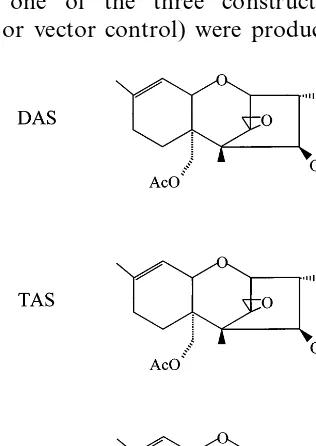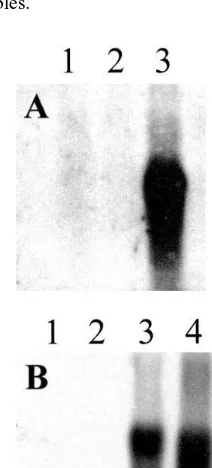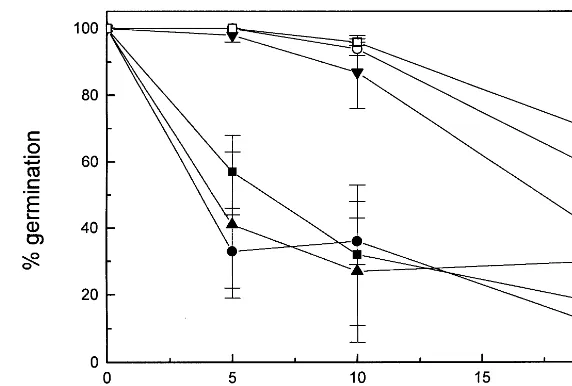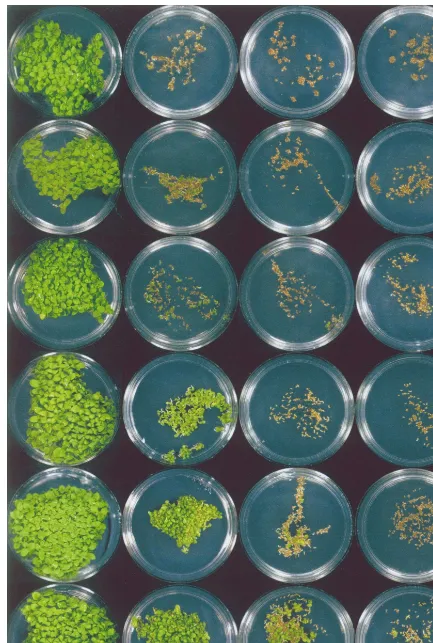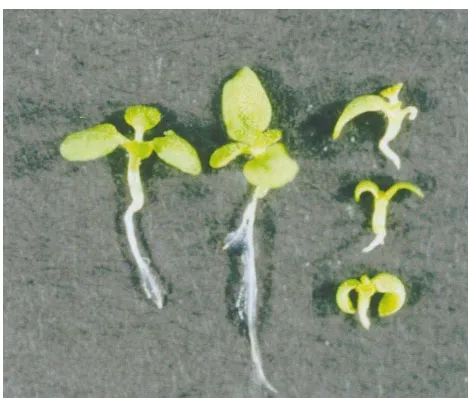Transgenic expression of the
TRI
101 or
PDR
5 gene increases
resistance of tobacco to the phytotoxic effects of the trichothecene
4,15-diacetoxyscirpenol
Michael J. Muhitch *, Susan P. McCormick, Nancy J. Alexander,
Thomas M. Hohn
1Mycotoxin Research Unit,National Center for Agricultural Utilization Research,ARS,USDA,1815 North Uni6ersity Street,Peoria,
IL 61604, USA
Received 25 February 2000; received in revised form 25 April 2000; accepted 26 April 2000
Abstract
Mycotoxins are fungal secondary compounds that are toxic to vertebrates. Their presence in food and feeds, as the result of fungal disease in crops, can present a danger to animal or human health. Many mycotoxins have also been shown to be phytotoxic and in some cases, such as with trichothecenes produced by the wheat head blight fungusFusarium graminearum, mycotoxins may act as virulence factors. Antibiotic-producing organisms, including fungi, protect themselves from their own toxins by metabolic alteration of the compound, modification of the target site of action or by exporting the compound to the extracellular space. We have tested the effectiveness of adapting two of these strategies, metabolic alteration and extracellular transport, to protect plant cells from the deleterious effects of the trichothecene 4,15-diacetoxyscirpenol (DAS). Tobacco plants were transformed with either the Saccharomyces cere6isiae gene PDR5, which encodes a multi-drug transporter, or with the Fusarium sporotrichioides gene
TRI101, which encodes a trichothecene 3-O-acetyltransferase. Both genes conferred significant increased tolerance to DAS as measured by a sensitive seed germination assay. Expression ofPDR5 orTRI101 in a seed-specific manner in crop plants such as wheat could lower the incidence of head blight as well as reduce mycotoxin levels within the seed. © 2000 Elsevier Science Ireland Ltd. All rights reserved.
Keywords:Tobacco; Plant disease resistance; Trichothecenes; Mycotoxins; Transgenic tobacco; Wheat head scab
www.elsevier.com/locate/plantsci
1. Introduction
Trichothecenes are cyclic sesquiterpene epoxide mycotoxins produced by several fungal species belonging to the genus Fusarium and related gen-era [1]. Trichothecenes are potent inhibitors of protein synthesis in eukaryotic cells [2] and act as virulence factors in plant diseases such as wheat
head scab due to their phytotoxic properties [3]. Trichothecenes are also of considerable interest because of their potential occurrence in animal feeds and human foods and the risk to health and agricultural productivity that their presence creates.
Mycotoxin-producing fungi have developed strategies to protect themselves from their own toxins [4]. In the case of Fusarium graminearum, for instance, trichothecene 3-O-acetyltransferase (TRI101) converts the highly toxic trichothecenes into considerably less toxic derivatives [5]. An-other protection strategy is to transport toxins out of the cell via membrane transporter pumps [6]. Either of these mechanisms could be adapted through the genetic engineering of crop plants to Abbre6iations: DAS, 4,15-diacetoxyscirpenol; DON,
deoxyniva-lenol; TAS, 3,4,15-triacetoxyscirpenol.
* Corresponding author. Tel.: +1-309-6816368; fax: + 1-309-6816686.
E-mail address: [email protected] (M.J. Muhitch).
1Present address: Novartis Agribusiness Biotechnology Research,
Inc., 3054 Cornwallis Road, Research Triangle Park, NC 27709, USA.
increase the resistance against Fusarium-caused diseases such as wheat head scab by increasing the plant’s tolerance to the trichothecene virulence factors. As a first step in applying these strategies, we tested the effects of expressing eitherTRI101, a
Fusarium sporotrichioides gene encoding tri-chothecene 3-O-acetyltransferase, or PDR5, a yeast gene encoding a multidrug resistance trans-porter [7], on the tolerance of transgenic tobacco to trichothecene inhibition of germination and plantlet development.
2. Materials and methods
2.1. Construction of 6ectors and plant
transformation
The PDR5 [8] and TRI101 genes [5] were am-plified by Pfu polymerase using templates ofSac
-charomyces cere6isiae genomic DNA (generously
provided by J. Golin, The Catholic University of America) and F. sporotrichioides cDNA, respec-tively. The amplified products were subsequently cloned into the pBI121 plasmid (Clontech) in place of the b-glucuronidase gene, as previously de-scribed [9]. A vector control plasmid, a pBI121 derivative that lacks theb-glucuronidase gene, was also generated and transgenic tobacco plants con-taining one of the three constructs (TRI101,
PDR5, or vector control) were produced [10].
2.2. Growth conditions and seed germination assay
Tobacco cell suspension cultures were propa-gated as before [9], but with the modification that culture volumes were scaled down from 100 to 20 ml and culture flasks were inoculated with 1 ml of 7-day-old cells rather than 4 ml. Tobacco seed germination studies were performed under aseptic conditions. Tobacco seeds were surface sterilized by incubation for 15 min in 10% (v/v) Clorox containing 0.1% Tween-20. Subsequently, the seeds were rinsed four times with sterile distilled water and then distributed onto 60-mm diameter petri plates containing MS salts and 30 g/l sucrose (pH 5.8). Plates, containing an average of 240 seeds, were incubated for 2 weeks under 16/8 h light/dark cycle, with average temperatures of 26°C (day) and 22°C (night). Afterwards, the plates were photographed, then the seeds were tallied by hand for germination (radicle emer-gence) using a dissecting microscope.
2.3. Trichothecene preparations
The trichothecenes 4,15-diacetoxyscirpenol (DAS) and 3,4,15-triacetoxyscirpenol (TAS) and (deoxynivalenol) DON (see Fig. 1) were prepared as described previously [11], dissolved in acetone to 0.1 M and added to the media, after it had been autoclaved, to final concentrations indicated. Pre-liminary experiments revealed that equivalent amounts of acetone alone (0.02% v/v) did not affect germination or plantlet development.
2.4. RNA blot analysis
Tobacco cell RNA blot analysis was performed as described previously [12], using the full length
PDR5 gene or the TRI101 cDNA as probes.
3. Results
Deoxynivalenol (DON) is a major trichothecene product of F. graminearum, the primary fungal species responsible for head scab in wheat, while DAS is generally produced byFusarium poaeaand
Fusarium equiseti, species regarded as minor fun-gal components of wheat head scab infection [13]. To develop a suitable test system for measuring phytotoxicity in our model transgenic (tobacco)
Fig. 2. Effects of DAS and TAS on the growth of tobacco suspension cells. Initial fresh weight of cells was approxi-mately 0.075 g per flask. Trichothecenes were added at day 0 and cells were incubated for 7 days. Data points represent the means of two samples. Error bars indicate the range of the individual samples.
While DAS effectively bleached leaf discs and prevented plantlet regeneration when cultured on regeneration medium, seed germination was deter-mined to be a more reliable and sensitive bioassay for monitoring trichothecene phytotoxicity and was used therefore to test the effects of PDR5 or
TRI101 expression on plant tolerance of trichothecenes.
It has been proposed that some of the tri-chothecene-producing Fusarium fungi possess the ability to protect themselves from their own toxins by acetylating the trichothecene ring at the three position [5]. To see if 3-O-acetylation also renders
Fusarium trichothecenes less phytotoxic, we com-pared the relative inhibitory effects of DAS versus TAS on tobacco suspension cell culture growth (Fig. 2). Acetylation of the 3-O position on the trichothecene ring of DAS appeared to strongly reduce its toxicity as measured by the fresh weight gain of the culture over 7 days. While alternative interpretations of the data are possible, such as a reduced uptake of TAS by the cells, these results encouraged us nevertheless to pursue the trans-genic approach toward reducing trichothecene phytotoxicity in tobacco.
The TRI101 or PDR5 genes were incorporated into separate plant expression cassettes and moved into tobacco viaAgrobacterium-mediated transfor-mation. A number of kanamycin-resistant tobacco cell lines were recovered for each transformant, as well as for the vector control, and all were tested in a preliminary T1 seed germination screen for increased trichothecene resistance (data not pre-sented). The most promising lines, (TRI1011,
TRI1013 and PDR56), along with two vector con-trol lines (P1 and P3), were characterized further. In all three experimental lines, RNA blot analysis revealed high level expression ofTRI101 orPDR5 genes, while the vector control lines lacked either transcript (Fig. 3).
With non-transformed tobacco seeds, DAS was shown to be an effective inhibitor of germination, with an I0.5 of approximately 6 mM. (Fig. 4). Moreover, DAS also appears to impede shoot morphogenesis as most of the seeds that did ger-minate in the presence of DAS did not proceed beyond the radicle stage (Fig. 5). In the presence of lower DAS concentrations, a few of the germi-nating seedlings produced chlorophyll within the rudimentary shoot zone while others produced plantlets with thick, stubby roots and small, curled
Fig. 3. RNA blot analysis ofPDR5 and TRI101 transgenic tobacco lines. Panel A, lane 1, P1 vector control; lane 2, P3 vector control; lane 3,PDR56 – 6. Blot probed with the PDR5 gene. Panel B, lane 1, P1 vector control; lane 2, P3 vector control; lane 3,TRI1011; lane 4,TRI1013. Blot probed with theTRI101 gene.
Fig. 4. Effects of various concentrations of DAS on tobacco seed germination. Data points represent a mean from three plates
91 S.D. , non-transformed control; , P1 vector control; , P3 vector control; , PDR56 – 6; , TRI1011;,TRI1013. Results forPDR5 seeds on 5mM DAS and for allTRI101 seeds on all concentrations of DAS were significantly different from their respective non-transformed seed controls as determined by the Student’st-test (PB0.05).
cotyledons and leaves (Fig. 6). In rare instances, DAS-treated seeds produce normal plantlets, which were devoid of chlorophyll.
Tobacco seed germination was significantly less susceptible to inhibition by DAS when the plants were transformed with either theTRI101 orPDR5 genes when compared with the non-transformed controls (Fig. 4). In fact, for all three experimental lines, germination was remarkably unaffected by DAS concentrations up to 10mM. In contrast, the germination was inhibited by DAS in the vector control transformants to the same degree as in non-transformed control.
The resistance of the PDR5 and TRI101 trans-formants was reflected not only in the higher percentages of germinating seeds, but also in the higher numbers of seedlings containing chlorophyll and that had proceeded with morphological devel-opment (Fig. 5). In this regard, thePDR5 and two
TRI101 seed lines were only slightly less vigorous in appearance when grown in the presence of 5mM DAS than any of the lines grown without DAS. In contrast, the few non-transformed or vector control seedlings that did develop green shoots in the presence of 5mM DAS were highly reduced in size compared with seedlings not challenged with DAS.
4. Discussion
The role of mycotoxins in plant disease has not
Fig. 6. Typical non-transformed tobacco seedlings incubated in the absence (the two larger seedlings on the left) and presence (three smaller seedlings on the right) of 5mM DAS.
eases remains to be tested and in this regard, transformation of wheat and barley with these same two genes is in progress in collaborating laboratories. Regardless of their role in plant dis-ease, the presence of mycotoxins in feeds and foodstuffs is a health concern for both animals and human beings, and approaches which seek to reduce mycotoxin levels within plant tissues could, at the least, improve the nutritional quality of plant-based foods and feeds.
Acknowledgements
The technical assistance of Kurtis Sollenberger and Marcie Moore is gratefully acknowledged. Names are necessary to report factually on avail-able data; however, the USDA neither guarantees nor warrants the standard of the products, and the use of the name by USDA implies no ap-proval of the product to the exclusion of others that may also be suitable.
References
[1] T.M. Hohn, Fungal phytotoxins: biosynthesis and activ-ity, in: C. Tudzynski (Ed.), The Mycota V. Part A. Plant Relationships, Springer, Berlin, 1997, pp. 129 – 144. [2] Y. Ueno, M. Nakajima, K. Sakai, K. Ishii, N. Sato, N.
Shimada, Comparative toxicology of trichothec myco-toxins: inhibition of protein synthesis in animal cells, J. Biochem. 74 (1973) 285 – 296.
[3] R.H. Proctor, T.M. Hohn, S.P. McCormick, Reduced virulence of Gibberella zeae caused by disruption of a trichothecene toxin biosynthetic gene, Mol. Plant-Mi-crob. Interact. 8 (1995) 593 – 601.
[4] E. Cundlife, How antibiotic-producing organisms avoid suicide, Ann. Rev. Microbiol. 43 (1989) 207 – 233. [5] M. Kimura, I. Kaneko, M. Komiyama, A. Takatsuki,
H. Koshino, K. Yoneyama, I. Yamaguchi, Tri-chothecene 3-O-acetyltransferase protects both the pro-ducing organism and transformed yeast from related mycotoxins, J. Biol. Chem. 273 (1998) 1654 – 1661. [6] E. Balzi, A. Goffeau, Multiple or pleiotropic drug
resis-tance in yeast, Biochim. Biophys. Acta 1073 (1991) 241 – 252.
[7] D. Dexter, W.S. Moye-Rowley, A.-L. Wu, J. Golin, Mutations in the yeastPDR3,PDR4,PDR7 andPDR9 pleiotropic (multiple) drug resistance loci affect the tran-script level of an ATP binding cassette transporter en-coding gene, PDR5, Genetics 136 (1994) 505 – 515. [8] E. Blazi, M. Wang, S. Letermre, L. Van Dyck, A.
Goffeau,PDR5, a novel yeast multidrug resistance con-ferring transporter controlled by the transcription regu-lator PDR1, J. Biol. Chem. 269 (1994) 2206 – 2214.
observation supports the view that species-specific tolerance toward particular mycotoxins is based on differences in the uptake, translocation, metabolism, and target sensitivity [13].
dis-[9] M.J. Muhitch, Effects of expressing E. coli threonine synthase in tobacco (Nicotiana tabacum L.) suspension culture cells on free amino acid levels, aspartate pathway enzyme activities and uptake of aspartate into the cells, J. Plant Physiol. 150 (1997) 16 – 22.
[10] N.L. Mathis, M.A.W. Hinchee, Agrobacterium inocula-tion techniques for plant tissues, in: S.V. Gelvin, R.A. Schilperoort (Eds.), Plant Molecular Biology Manual, vol. B6, Kluwer Academic Publishers, Boston, 1994, pp. 1 – 9. [11] S.P. McCormick, N.J. Alexander, S.E. Trapp, T.M. Hohn, Disruption of FsTRI101, the gene encoding tri-chothecene 3-O-acetyltransferase, from Fusarium sporo-trichioides, Appl. Environ. Microbiol. 65 (1999) 5252 – 5256.
[12] R. Rastogi, P.S. Chourey, M.J. Muhitch, The maize glutamine synthetaseGS1 – 2gene I preferentially expressed in the kernel pedicels and is developmentally-regulated, Plant Cell Physiol. 39 (1998) 443 – 446.
[13] M. McLean, The phytotoxicity of fusarium metabolites: an update since 1989, Mycopathologia 133 (1996) 163 – 179.
[14] A.E. Desjardins, G.F. Spencer, R.D. Plattner, M.N. Beremand, Furanocoumarin phytoalexins, trichothecene toxins and infection of Pastinaca sati6a by Fusarium
sporotrichioides, Phytopathology 79 (1989) 170 – 175. [15] D. Packa, Cytogenetic changes in plant cells as
influ-enced by mycotoxins, Mycotox. Res. 7 (1991) 150 – 155. [16] W. Wakulinski, Phytotoxicity of the secondary metabo-lites of fungi causing wheat head fusariosis (head blight), Acta Physiol. Plant 11 (1989) 301 – 306.
[17] M. McLean, The phytotoxicity of selected mycotoxins on mature, germinating Zea mays embryos, Myco-pathologia 132 (1996) 173 – 183.
[18] M.B.M. Bruins, I. Karsai, J. Schepers, C.H.A. Snijders, Phytotoxicity of deoxynivalenol to wheat tissue with regard to in vitro selection for Fusarium head blight resistance, Plant Sci. 94 (1993) 195 – 206.
[19] Q. Zhu, E.A. Maher, S. Masoud, R.A. Dixon, C.J. Lamb, Enhanced protection against fungal attach by constitutive co-expression of chitinase and glucanase genes in transgenic tobacco, Biotechnology 12 (1994) 807 – 812.
